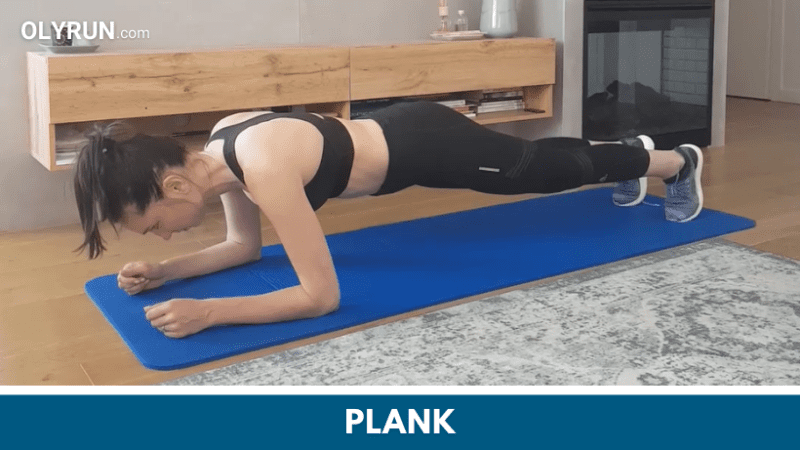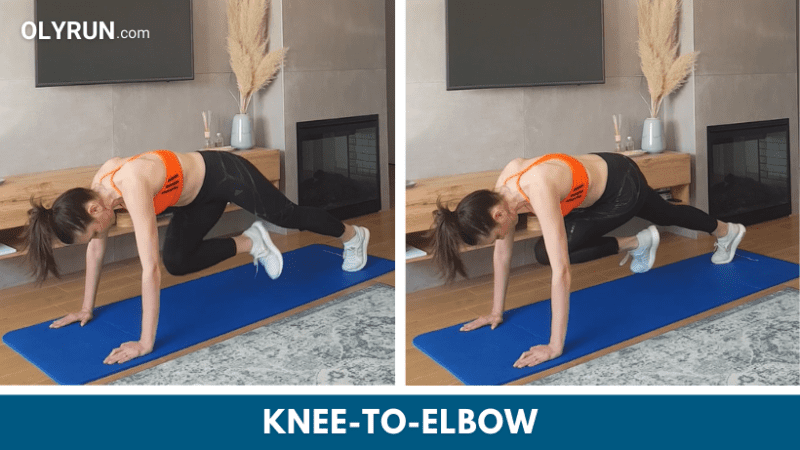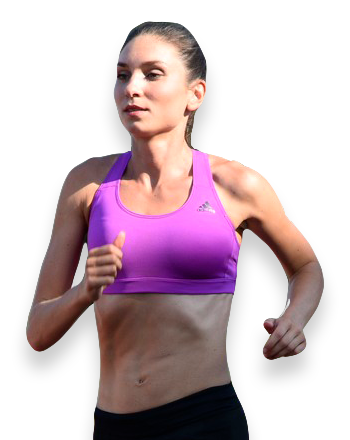Key Muscles Used in Running (8 Main Muscle Groups)
Wondering which muscles are used during running and what exercises you need to do to strengthen them?
In this article, I will go through the 8 muscles used in running.
I will describe every muscle in detail and, with examples, show you how to strengthen them.
The main muscles used in running
Muscles are every runner’s best friend.
They allow you to run, to move. They tell you when you’re doing something wrong and warn you when you’re overdoing it.
1. Core muscles
Core muscles ensure control and stability of all movements in running.
A strong core is a key to effective movement. In running, where your arms and legs move in a circular motion, the central part of the body must be stable.
The lower body and pelvis must be extremely strong since they are the meeting place for the forces generated in the upper and lower body.
Anterior core muscles include abdominal muscles, which stabilize the core and work together to control movements of the spine and pelvis in all three planes of motion.
Posterior core muscles include back muscles, which are often less developed in runners. When running, these muscles are in charge of the body’s stability from the shoulders all the way to the pelvis, as well as for control of the movements of the spine.
Info
If you have weak core muscles, you will not be able to maintain proper running form. This most often leads to compensation in other muscles, which can lead to injury.
How to strengthen core muscles?
An excellent exercise for strengthening core muscles is the plank.

Perform the exercise for 30 to 60 seconds as follows:
- Get into the starting position, face down with your elbows and toes on the floor. Your feet are hip-width apart. The elbows are perpendicular to the floor and are right below your shoulders, with the forearms facing forward. Your head, neck, and spine are straight, and you are looking down at the floor.
- Tighten your muscles and hold this position.
2. Hip flexors
Hip flexors are muscles located in the front of the hips, right above the thighs.
They connect the femur, lower back, hips, and groin. In running, they are used when lifting the legs, but also when moving the legs forward at the hips.
The hip is an important joint that requires mobility, as well as stability.
Every runner must be able to control the movements of the hips, especially when the whole weight of the body is on one leg. Hip stability enables alignment of the knee and pelvis.
Due to that, runners who do not have strong enough hip muscles often have problems with knee and back injuries.
Research has shown that hip flexors must generate a force 10 times greater than the weight of your legs in order to do their job successfully.
This means that hip flexors are extremely powerful, but also prone to tightening, which shortens your stride.
By improving hip mobility, you can increase the length of your stride, which is one of the key components of fast running.
Read more: 15 Essential Mobility Exercises For Runners
How to strengthen hip flexors?
An excellent exercise for strengthening the hip flexors is knees-to-elbow.

Perform the exercise for 30 to 45 seconds as follows:
- Start in a high plank position with arms perpendicular to the floor. Arms and legs are shoulder-width apart.
- Pull the knee of your right leg to the elbow of your left arm.
- Return to the starting plank position.
- Repeat the same movement with your left leg.
- Continue switching sides until the end of the exercise.
3. Glutes
Glutes are located in the buttocks and consist of three primary muscles: gluteus maximus, gluteus medius, and gluteus minimus.
One fun fact is that the gluteus maximus is the largest muscle in the body.
Strong glutes play an important role in running since they are the muscles that move you forward.
In addition to hip flexors, they are also responsible for moving the leg forward at the hip.
Weak glutes usually lead to knee pain and bad posture.
How to strengthen glutes?
An excellent exercise for strengthening the glutes is the bridge.

Perform the exercise for 30 to 45 seconds as follows:
- Get into the starting position, face up with shoulders and feet on the floor. Legs are slightly bent at the knee at right angles and are hip-width apart. You are looking up.
- Tighten your muscles and hold this position.
4. Quadriceps
The quadriceps is a muscle group that consists of four long muscles on the front of the thigh and is one of the longest and most complex muscles of the human body.
In running, their task is to extend the leg at the knee.
They are also responsible for straightening and stabilizing your knees when you run.
How to strengthen quadriceps?
An excellent exercise to strengthen the quadriceps is the squat jump.

Perform the exercise for 30 to 45 seconds as follows:
- Stand in the starting position so that your feet are hip-width apart, look straight ahead, and hold your upper body straight.
- Get into a half-squat position so that your thighs are parallel to the floor.
- Swing your arms and jump as high as you can.
- Land back in the starting position.
- Repeat the movement until the end of the exercise.
5. Hamstrings
Hamstrings have a completely opposite role in running from the quadriceps.
Their task in running is to bend the knee, that is, to lift the feet towards the buttocks.
How to strengthen your hamstrings?
An excellent exercise to strengthen the hamstrings is the reverse lunge jump.

Perform the exercise for 30 to 45 seconds as follows:
- Start in a lunge position, look straight ahead, and keep your upper body straight.
- Jump while lifting your left knee into the air, reflecting yourself with the right leg.
- Land on the right foot and return to the starting position.
- Repeat the movement until the end of the exercise.
- Repeat the exercise on the opposite side.
6. Calf muscles
Calf muscles are situated on the back of the lower leg.
Their task in running is to stretch the feet during reflection, that is, every time the foot hits the ground.
Likewise, the calf muscles are responsible for absorbing impact on landing, providing balance and mobility to the ankle.
The movement that activates the calf muscles is called plantar flexion (the action of stretching the foot downwards).
Read more: 10 Simple Ankle Mobility Exercises For Runners
How to strengthen calf muscles?
An excellent exercise to strengthen the calf muscles is the toe walk.

Perform the exercise as follows:
- Begin by standing with your feet hip-distance apart, look straight ahead, and keep your upper body straight.
- Stand on the balls of your feet.
- Leaning on the balls of your feet, walk 10 meters forward, and maintain balance with your hands.
7. Tibialis anterior
The tibialis anterior muscle is situated on the anterior of the lower leg, and its task is to bend the foot upwards.
The movement that activates the tibialis anterior muscle is called dorsiflexion (the action of raising the foot upwards).
One of the common injuries in beginners is shin splints (medial tibial stress syndrome), which is caused by weak tibialis anterior muscles.
How to strengthen the tibialis anterior muscle?
An excellent exercise to strengthen the tibialis anterior muscle is the heel walk.

Perform the exercise as follows:
- Begin by standing with your feet hip-distance apart, look straight ahead, and keep your upper body straight.
- Raise your toes off the ground, leaning on your heels.
- Leaning on your heels, walk 10 meters forward, and maintain balance with your hands.
8. Heart
Many often forget the most important muscle in our body, the heart. Without the heart, there is no life and, with it, no running.
Our cells need a constant supply of oxygen, which, in addition to glucose, provides us with energy.
In running, this process becomes much more pronounced as you strain your body and require additional energy.
In order for runners to be able to run fast and maintain that pace for a longer period, the lungs need to bring enough oxygen into the blood.
After that, the heart sends oxygen-rich blood to cells around our body.
It is extremely important for runners to bring enough air into their lungs and enough oxygen into their blood supply.
Many believe that this depends on lung capacity, that is, on the amount of air that you can take into your lungs.
However, this is incorrect. In reality, most long-distance runners have relatively small lungs, but their heart works much more efficiently and allows them to send greater quantities of oxygen into their muscles.
As an adjustment to increased physical exertion, the athletic heart syndrome occurs, meaning that the heart becomes enlarged, while the resting heart rate is lower.
The enlargement of the heart depends on the type of sports activity, intensity, training frequency, years of training, gender, and the constitution of the athlete.
How to strengthen your heart?
Every physical activity is good for strengthening the heart, including running.

Can you gain muscle from running?
High-intensity short-distance running builds leg muscles, while low-intensity long-distance running causes significant muscle damage, preventing their growth.
Research was conducted on 12 recreational runners who did high-intensity interval training (HIIT) 3 times a week. The workout consisted of 4 sets of 4 minutes of running at 90–95% of maximum heart rate, followed by 3 minutes of active recovery. After 10 weeks of training, the muscle fibers of their quadriceps were increased by about 10.6%. This research proves that you can gain leg muscles with high-intensity running.
Research conducted on 30 male recreational long-distance runners has shown that running long distances at low intensity prevents muscle growth.
Does running also work tendons and ligaments?
Besides muscles, running also works tendons (connective tissues that connect bones to muscles) and ligaments (connective tissues that connect bones to each other).
Tendons and ligaments both absorb the forces created by running and, with that, help stabilize the body.
How to warm up your muscles before running?
Each type of training or race requires its own warm-up routine.
A complete warm-up routine before running includes:
1. Easy jog or a walk – aerobic activities of low intensity (5-15 minutes)
2. Mobility exercises and dynamic stretches (5-10 minutes)
3. Running drills (5-10 minutes)
4. Strides (1-8 minutes)
In the article Warm-up Routine Before Running (Training/Racing), I explained exactly how to warm up before each type of training or race and how to develop your own warm-up routine.
Research shows that proper warm-up results in an increase in body temperature by 2-3% which lasts for 45 minutes. The increase in body temperature leads to useful changes in our muscles and tendons:
- Significantly boosts the elasticity of muscles and as a result, allows an exercise of higher intensity.
- Muscles and tendons become more flexible which makes stretching easier and more effective.
- Boost in enzymes and metabolic activities helps the effectiveness of muscle contractions.
What muscles are used when running uphill?
When running uphill, in comparison to running on flat ground, we use the tibialis anterior muscle, hip flexors, quadriceps, hamstrings, and glutes more intensely.
It is also necessary to work with your arms more, and due to that, we use the upper body and arm muscles more intensely. Due to increased exertion in uphill running, the heart pumps faster as more oxygen needs to be brought to muscle cells in order to produce energy.
When running uphill, keep your body straight, slightly leaning forward at the hip. Look straight in front of you, and not at your feet so that you don’t hunch over. Work with your arms more intensely and don’t overstride.
What muscles are used when running downhill?
When running downhill, in comparison to running on flat ground, we use our core, glutes, hamstrings, and hip flexors more intensely. Due to greater impact force on the joints, downhill running also works your calf muscles more intensely.
When running downhill, run at a slow, controlled pace.
Check your form. Don’t lean too far backward and don’t increase the stride length because that increases the braking force and, with that, the possibility of injury.
How do you develop muscular strength and endurance?
Muscle strength is the ability of a muscle to overcome resistance by contraction. To increase strength, use heavier weights and do lower repetitions.
Muscle strength is important when running with resistance, for example when running uphill and when in strong headwinds.
It helps to improve your posture, which will increase running efficiency and prevent the risk of injury. The best time to develop strength is in your off-season.
Muscle endurance is the ability of a muscle to overcome resistance over an extended period of time. To increase muscle endurance, use moderate weight and do higher repetitions.
Muscle endurance is important when running long distances and can develop throughout the year.
Read the article Strength Training for Runners (Top 19 Strength Exercises) to find out what exercises runners need to do to improve muscle strength and endurance.

Matea Matošević
Hi, I’m Matea! I’m an Olympic Marathon Runner, founder, and writer behind OLYRUN.com. On this site, I provide help in the form of my knowledge and experience to all who love running and active living. Read more…

